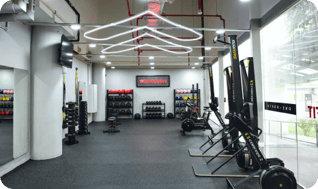When it comes to the pantheon of exercises, few would contest that the squat is up there with the best of them. Whether you’re a beginner or an experienced lifter, squats deserve a place in your weekly routine. Not only are they an excellent way to strengthen your lower body, but they also bring numerous functional benefits that will carry over to other exercises and daily activities.
Why squats are great
Squats are a fundamental movement pattern that mimics what you do daily–sitting down and standing up. When done properly, they engage the quadriceps, hamstrings, glutes, and core (“compound exercises”), making them an efficient way to improve overall strength, stability, and mobility in your lower body.
But the benefits don’t stop there. Compound exercises such as squats trigger a bigger hormonal response from the body as they simultaneously engage multiple muscle groups. This leads to the release of important hormones like testosterone, growth hormone, and endorphins, which can significantly impact key bodily functions and mood.
How to squat correctly
Now you know why you should squat, it’s important to learn how to squat. Mastering the movement is critical to prevent injury and to get the most out of your sets and repetitions (“reps”). Here’s our 5-step guide on how to properly perform a bodyweight squat, the movement in its most fundamental form:
- Stand with your feet shoulder-width apart and your toes pointing slightly outward.
- Engage your core by drawing your belly button toward your spine. This helps protect your spine during the movement.
- Push your hips back as if you're sitting in a chair. Your knees may stay in line with your toes or slide forward–either way, ensure your weight is distributed primarily on your heels.
- Stop when your thighs are parallel to the floor. If you’re unable to get that deep, just go as low as your flexibility allows.
- Push through your heels to return to standing, lightly squeezing your glutes at the top.
Don’t worry if you’re unable to perform the perfect squat–as with most things in life, practice makes perfect. Focus on proper form and be aware of any aches or pains during the movement.
Squat variations
Now you know the basics, let’s look at some of the most popular squat variations. Each one has different benefits that may have a place in your programme depending on your goals and ability level.
1. Back squat

The back squat is the most common form of squat with the weight (typically a barbell) placed across your upper back. This variation is great for building overall strength and power in your lower body and may improve posture, however, the exercise requires proper technique to avoid lower back strain.
The back squat is typically performed with feet shoulder-width apart, but you can try widening your stance to target better your inner thighs and glutes (“sumo squats”).
2. Front squat

The front squat is the same as the back squat apart from the fact that the weight is held on the front of your shoulders. This places more emphasis on your quads and core, which can help improve your balance and stability. A limiting factor for many individuals is the flexibility required in the wrists and shoulders to hold the weight on the shoulders, but this can be rectified by using straps to reduce the demand on these joints.
3. Goblet squat

Goblet squats are an excellent option for beginners who may feel intimidated or uncomfortable bearing weights on their back or shoulders; they are performed with a dumbbell or kettlebell held in the hands in front of the chest. Individuals may choose to progress from goblet squats relatively quickly as the weight becomes too heavy to hold in the hands comfortably.
4. Bulgarian split squat

There’s a running joke that the hardest gym exercises are the ones named after Eastern European countries, and the Bulgarian split squat is no exception.
As the name implies, this is a single-leg variation of the squat where your back leg is elevated on a bench or other platform. As torturous as it may be, it’s an excellent option to target the glutes and quadriceps and helps improve unilateral (single-side) strength and balance.
5. Pistol squat

The pistol squat is another challenging single-leg exercise that requires strength, balance, and a high degree of mobility. While it’s a great test of lower body strength and control, most beginners will need to work through a progressive programme to build towards the exercise–it will require practice.
7. Hack squat

The hack squat is the only one of these squat variations that requires a specialised machine. While that does limit the accessibility of this exercise, the hack squat is a safer way to load your legs heavily without worrying too much about balance. This movement places more emphasis on your quadriceps and is a good option for both beginner and advanced lifters.
Workout recommendations
Sets and reps
As with all exercises, the number of sets and reps largely depends on your goals. For most individuals, a starting point of 3–4 sets of 8–12 reps is a good option, but when you have more specific objectives, those numbers should change:
- For strength: 3–5 sets of 3–6 reps with heavier weights.
- For hypertrophy (muscle growth): 3–4 sets of 8–12 reps with moderate weights.
- For endurance: 2–3 sets of 15–20 reps with lighter weights.
Regardless of your goal, you must listen to your body and adjust the volume and weight depending on how you feel as you progress.
Leg day versus full body
There are countless ways to program squats into your weekly exercise routine, so it's understandable if you’re unsure whether to dedicate a day to lower-body exercises or just include squats as part of a full-body workout.
Our recommendation is to do a squat-type movement at least 2–3 times weekly. This will ensure that you steadily improve lower-body strength and endurance over time alongside other beneficial leg exercises. With this recommendation, you can plan your weekly workouts, for example:
- Person A lifts weights two times per week: They may consider full-body workouts so they can squat at least two times weekly.
- Person B lifts weights four times per week: They may consider a version of a Push, Pull, Legs programme with a leg day, a push day, a pull day, and then another leg day weekly.
Navigating the ups and downs
Take a breath … that was a lot of information! We made it as easy to understand as possible, but the world of exercise programming can be difficult to navigate, especially if you have specific conditions or goals.
We understand that your fitness journey is unique and we’re here to guide you through every step. Our team of dedicated coaches are here to recommend the best program, exercises, and variations, ensuring you make steady progress towards improving your overall fitness, strength, and health.
We see your time working with us not just as a fitness experience but also as a chance to learn new skills and empower yourself with the knowledge that will last a lifetime. Our coaches will ensure you understand how to perform exercises correctly to avoid injury and maximise results. Whether you prefer free weights, body weight, or machine-based squats, we can tailor your programme to fit your experience and ability.


.png?width=301&height=187&name=Website%20Navigation%20Images%20(3).png)

-1.jpg?width=1984&height=1196&name=UFIT%20Club%20Street%20Front%20(4)-1.jpg)






